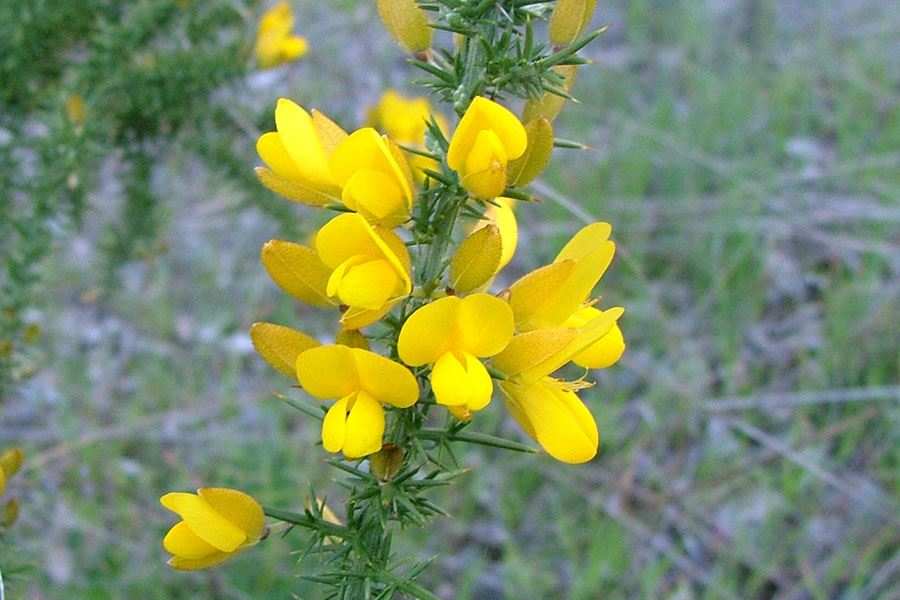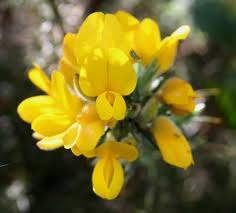
Gorse flowers and thorns, available all year long depending on climate.
Ulex europaeus: Edible Gorse or Furze Pas
Gorse has edible flowers. It also has thorns… Really bad thorns.
In August 2005 an Englishman, Dean Bowen, 32, left to walk home after many drinks at the local pub. He woke up the next day in the middle of a Gorse patch. Bowen couldn’t remember how he got there, and couldn’t find a way out of the thorny mess.
On his second day stranded in the patch he caught the attention of a passerby by using a cigarette lighter to reflect sunlight. That brought the rescue squad but they couldn’t get to him. He was surrounded, as they say, in a thorny situation. Bowen was eventually rescued by the British Royal Air Force who lifted him out by helicopter.
“I wouldn’t advise anybody to go into it [gorse bushes], you know what I mean? At first it seems fun but, before you know it, you’re like stuck,” Bowen, from Hunmanby, North Yorkshire, told the BBC after his rescue. “Whichever way I turned it seemed to be the wrong one that day.”
Bowen spent some time in the local hospital recovering from mild hypothermia and dehydration. Colin Yorke, who winched him to safety, said: “The man was in a patch of gorse brush 10-feet deep.
“We’ve no idea how he got there. He was right in the middle of the gorse. It was like he had been dropped there by a spaceship… It was certainly one of our stranger rescues.”
There is a saying: “When Gorse is out of bloom kissing is out of season.” That’s understandable since it is an evergreen that blooms year round. A spray of Gorse used to be put in bridal bouquet as an allusion to this. Pliny said Gorse was used in the collection of gold. The plant was put on stream beds to catch any gold-dust brought down by the current. It’s also been used for fuel in bakers’ ovens and in soap-making, as it contains much alkali. If the spines are crushed it is acceptable animal fodder. It has half the protein of oaks, not bad for wild fodder. Horses in particular like it especially tender young tips.
Gorse is common in western Europe and has been naturalized in Coastal Australia, New Zealand, South America and North America. In North America it is found along the Mid-Atlantic states, the west coast from California north into Canada, and Hawaii. It can also be found inland.
The only edible part for us are the flowers which have a slight coconut aroma and almond taste. They’ve been used in salads, for tea and to make a non-grape wine — recipe below. The buds can be pickled like capers. Don’t over eat them. The plant contains slightly toxic alkaloids. Soaked seeds are a flea-repellant.
Botanically known as Ulex europaeus (YEW-lex yew-row-PEE-us) Gorse is also called Furze. Ulex is Latin for some unknown ancient plant and Europaeus is of Europe. The word “gorse” comes from the Anglo -Saxon word “gorst” which is a descendant of a German word meaning barley which makes no sense at all. The word “furze” comes from the Anglo-Saxon word “fyrs” which means ‘a waste’ suggesting where it grows or the litter that accumulates around it creating a fire hazard. Gorse is on many noxious weed lists and is myrmecochoric meaning its seeds are distributed by ants.
Green Deane’s “Itemized” Plant Profile
IDENTIFICATION: Evergreen shrub to six feet, sometimes 10, forming dense and impenetrable thickets, young stems green, leaves modified into green spines, 0.4-1.4 in long, young seedlings have trifoliate leaves resembling a small clover leaf. Flowers are golden yellow, 0.4-0.8 in) long, with egg-shaped bracts and has a typical pea-flower structure. NON-EDIBLE: pod, long and dark, purplish brown, 2-3 small blackish seeds.
TIME OF YEAR: Year round if the climate agrees, heavily in spring.
ENVIRONMENT: Non-arid areas neither too hot or too cold, coasts, disturbed ground, grasslands, shrub lands, forest edges, waste places also as a hedge and in landscaping. Can grow in some shade. Makes soil poorer.
METHOD OF PREPARATION: Flowers as a trail-side nibble, or use to make tea or wine. Buds can be pickled. Do not consume a lot. Flowers have been used as a dye for Easter eggs. Flowers and roots provide a yellow dye for clothes.
Gorse Wine Recipe
* 12 cups of gorse flowers
* 1 gallon of water
* 4 cups of sugar (can substitute with honey, 3.3 pounds)
* 1 1/2 cups seedless white raisins
* 2 oranges
* 2 lemons (or 1/4 oz. citric acid)
* 2/3 cup strong tea or 8 drops grape tannin
* 2 heaping teaspoons all-purpose wine yeast
* 1 teaspoon yeast nutrient
(Optional, two ounces of ginger root)
Put the flowers into the fermenting bucket immediately. Boil half the water, half the sugar and the chopped raisins together for 1 to 2 minutes, then pour over flowers. Thinly peel the rind from the oranges and the lemons, and add to the bucket. Squeeze out the juice and add that too. Add the cold tea or the tannin and stir thoroughly. Make up to 1 gallon with cold water. When tepid add yeast and yeast nutrient, stir well and cover. Ferment for 1 week, stirring daily. After 2 or 3 days, when fermenting well, add the remaining sugar and stir to dissolve. Strain through a sieve or cloth and siphon into a gallon jug or bottle. Fill up to the neck or the jug with cool, boiled water. Rack when clear, bottle and keep for six months.


